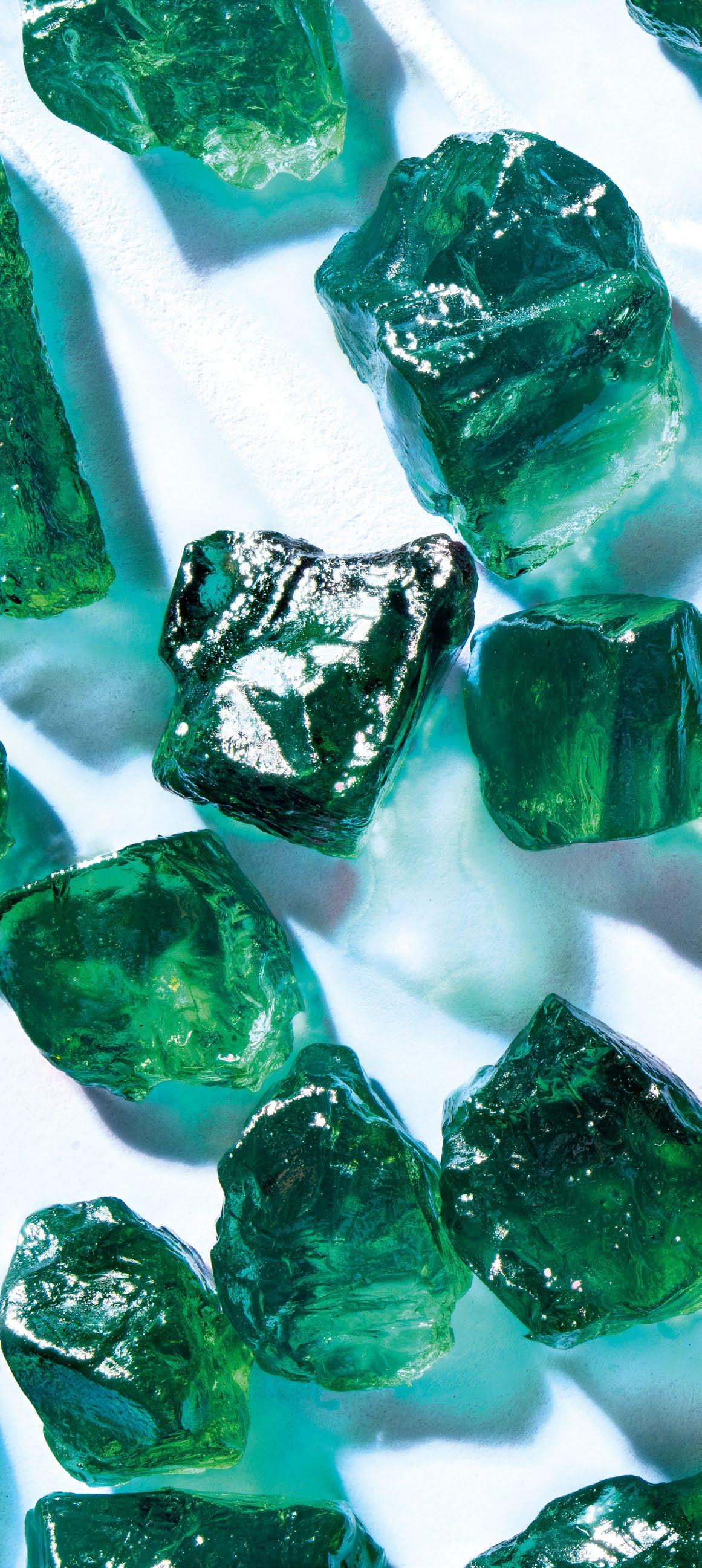




I am pleased to present the first edition of a new Gemfields newsletter. This bi-annual report aims to provide valuable updates from our mines and the market, covering our production, marketing efforts, projects in the pipeline and more.
Just like the hues of our gemstones, views and opinions are personal and may vary… if you have comments, questions or suggestions for future editions, please contact me, as I would love to hear from you. My details are below.
Gemfields celebrated its Emerald Anniversary this year, marking 20 years of business! As we hail this milestone, we can’t help but stop and reflect on how the world of coloured gemstones has changed and evolved during this (relatively short) time.
When it comes to emeralds, we have witnessed an undeniable increase in appreciation and desirability of this Zambian gem in international markets. Thanks to our collective promotional efforts, there is a growing demand for premium emerald production from international jewellery brands wishing to incorporate it into their bridal and fine collections.
I recently reflected with someone about how Zambian emeralds' sweet spot has increased from the original calibration enquiries to the 5ct mark. This is a wonderful development in such a short space of time, and to me, it seems to show how desirability is often linked to transparency in business.
Mozambican rubies have also followed some amazing trends! To quote a published article by GIA: "In less than a decade, Mozambique has become the world’s most productive source for gem-quality rubies.” The appeal of rubies appears to be less determined by their “country of origin” than is the case with emeralds, and we see demand and values continuing to rise as a testament to the timeless beauty of this gem.
We believe that a professional and dependable supply has been the key to unlocking growth in the coloured gemstone sector, and Gemfields’ proprietary grading system has assisted our auction customers in targeting their specific product selections.
We are honoured to be part of this history, and we very much look forward to the next 20 years!
All the best,
Head of Partnerships & Product – Downstream

Have
elena.basaglia@gemfields.com



The coloured gemstone market continued to grow, with Gemfields perfectly positioned by operating two world-class and market-leading mines, Kagem and MRM. Gemfields has passed the milestone of USD 2 billion in cumulative emerald and ruby auction sales since its first auction in 2009, with more than USD 400 million in taxes having been paid to the governments of Mozambique and Zambia.

Operationally, 2023 saw mixed performances. Although emerald and ruby production was weaker at times, leading to the withdrawal of the November HQ auction, the Gemfields Group was in a solid position to make meaningful investments in developing areas of our operations.
The announced investment in a second processing plant at MRM and the redevelopment of the sorting unit at Kagem will assist our ability to provide a stable supply of gemstones to the market. Working with a natural product, we are fully aware that there will be variations in the quality and quantity of the coloured gemstones that the Group produces, but based on historical trends, production is expected to improve at both mines.

A full schedule of auctions is expected to run in 2024, with the CQ (commercial quality) emerald action recently concluded in Jaipur. For the full announcement, please click on this link.

The construction of the second processing plant at MRM, our single largest-ever investment, is currently on schedule to be completed in the first half of 2025. This will triple MRM’s processing capacity from the existing 200 tonnes per hour to 600 tonnes per hour, allowing MRM to bring additional size and colour variations of rubies to market.
Kagem experienced a general improvement in both the quality and quantity of premium emeralds recovered in recent months.
In March 2024, Gemfields announced updated figures for the ‘G-Factor for Natural Resources’ for its two key mining subsidiaries (the Kagem emerald mine in Zambia and the Montepuez ruby mine in Mozambique.
The ‘G-Factor for Natural Resources’ is a measure that promotes greater transparency regarding the level of natural resource wealth shared with the governments of host countries, whether from the mining, oil, gas, timber or fishing sectors.
Kagem paid the Zambian government USD 28.3 million in taxes, royalties and dividends in the financial year 2023. This represents 31 percent of its total revenue of USD 97.7 million for the period under review.
MRM paid the Mozambican government USD 53.2 million in taxes and dividends in 2023. This represents 35% of its total revenue of USD 151.3 million for the period under review.

Several factors influence emerald recovery from the ground. In an area of 44 square kms, Kagem (‘Ka’ for Kafubu and ‘gem’ for gemstone) currently includes three principal open-cast pits.
The largest and deepest, Chama, has historically produced the majority of Kagem’s emeralds. Chibolele and Fibolele are considerable in size, but less developed. All of them are situated along the ‘Kafubu pegmatite field’, which runs across the Kagem concession and is known to have the potential for emerald mineralisation due to its mineral composition. The exploration campaign also continues at Kamakanga with an objective to confirm the host lithology and, in the near future, to establish the resources to enhance Kagem’s overall production profile.
Emeralds at Kagem are most likely formed at the intersection between the white pegmatite that runs across the layer composed of TMS (talc magnetite schist). These rocks bear different minerals, and emerald crystallisation occurs when they meet in a specific environment of temperature and pressure.
The emerald-bearing area in the Chama pit currently lies 140 metres below ground level, so Kagem teams operate 24 hours a day, with mining done in daylight and waste-stripping at night. The work done during the darker hours is just as important, as it aims to prepare the area for the chisellers whose task is to unearth the gemstones from the ground during the day.
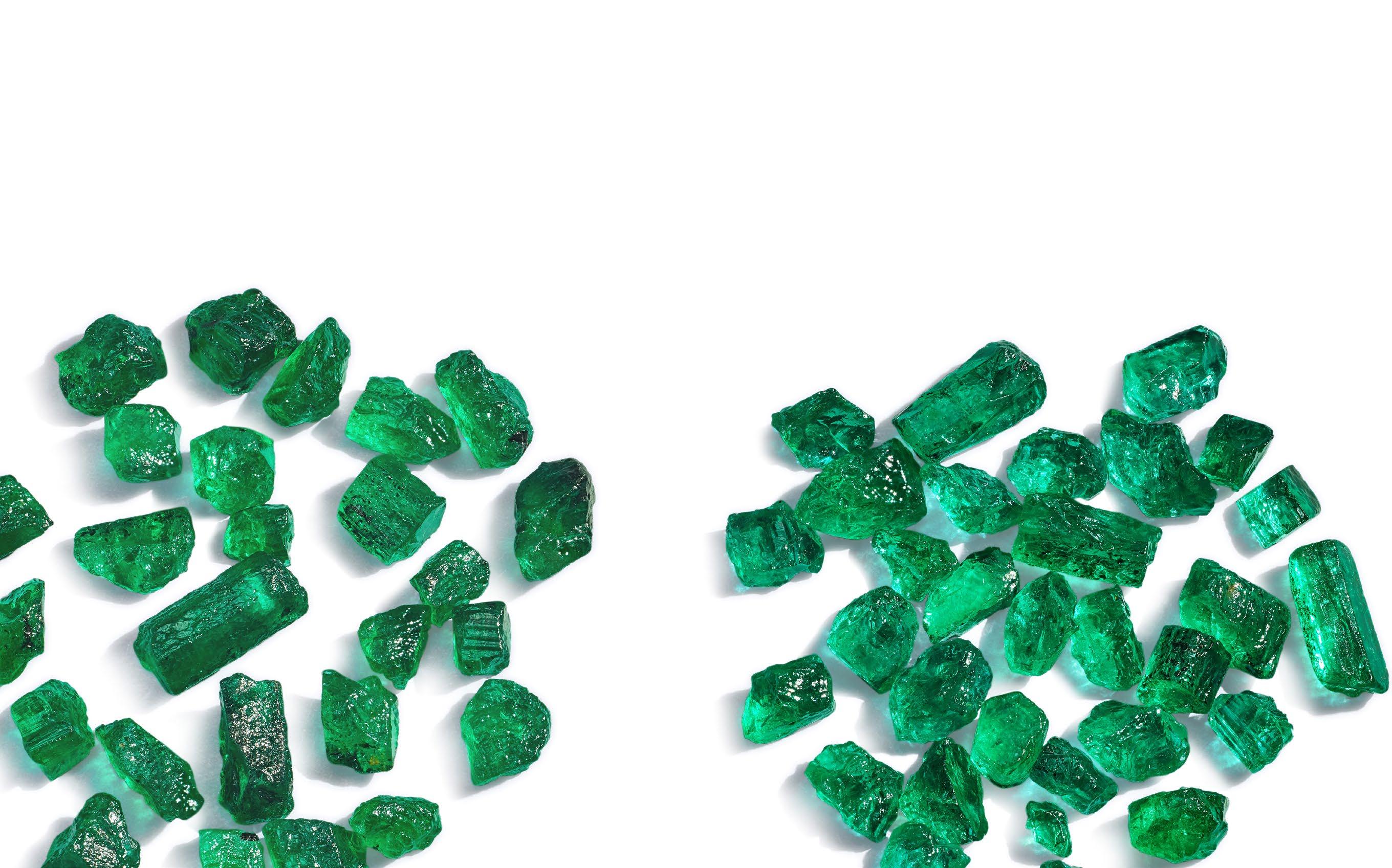

Kagem keeps a record of each pit’s production as an informative element, which helps to determine where to focus mining and expansion efforts and activities in and around the pits.

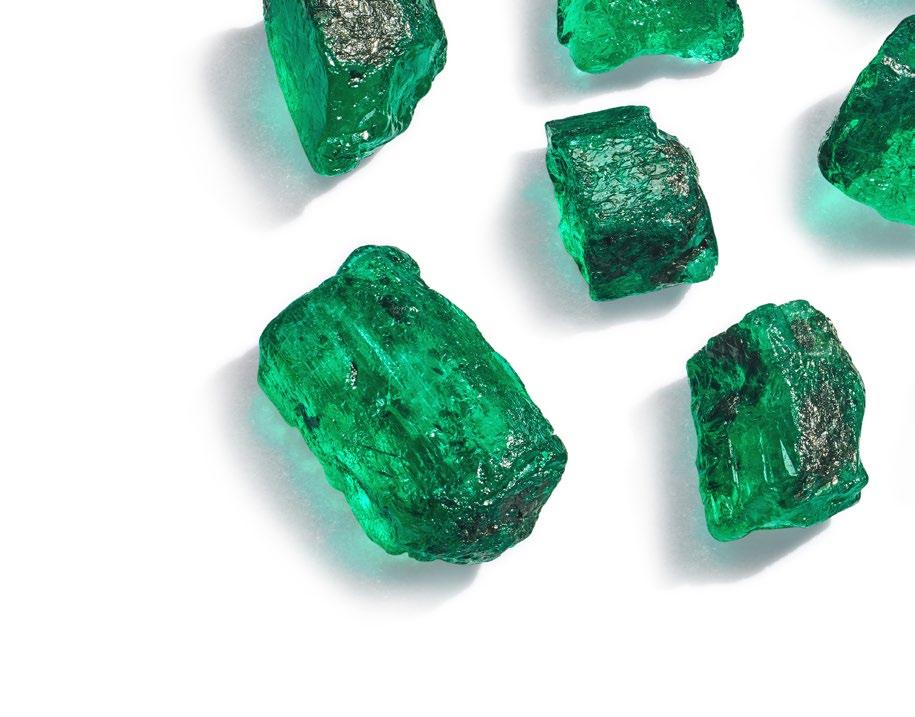
Despite the fact that it is difficult to assign a single type of product to each pit, a good selection of high-quality emeralds was unearthed from the Chama pit this year.
The Kagem mining team is busy expanding certain areas of operations, which gives us confidence that production will continue to improve. In particular, Fibolele production was promising; overall, we noticed a larger percentage of green versus bluer recovery with good competency; a few large pieces (sizes 5 and 6) have been recovered for the next HQ Emerald Auction, which sends a promising signal for future production.
Kagem is proudly changing gender stereotypes in mining. The once unconventional sight of a woman skilfully operating heavy-duty machinery at a mine is now becoming commonplace at Kagem.






The Montepuez deposit exhibits a complex deformation history, resulting in intricate structural configurations of sub-surface geological units.
Ruby mineralisation at Montepuez occurs in two distinct settings: primary mineralisation associated with amphibolites and secondary mineralisation hosted within gravel beds.
While the current exploration and production focus lies on the historically rich secondary mineralisation, efforts have also targeted primary mineralisation within the amphibolites.
Montepuez Ruby Mining (MRM) primarily operates three main clusters of production open-cast pits in separate areas for secondary mineralisation: Mugloto, Maninge Nice and Glass, covering a total lease area of 350 square kms. Approximately 100 square kms of this area is explored using the auger-drilling method for secondary mineralisation, while primary ruby production is restricted to the Maninge Nice area.
Mining at MRM occurs primarily at depths ranging from 7 to 8 metres, with a maximum depth of 11 metres. The main challenges in mining and production stem from the frequent sharp undulations of the basement and the heterogeneous distribution of mineralisation. These undulations slow down mining operations, while the heterogeneous nature of mineralisation presents surprises in production.
MRM conducts continuous mining operations, with ore and waste-mining during daylight hours and exclusively waste-stripping during darker hours.

At MRM, each mining block is divided into sections, which allows a focused approach to mining the asset and accurate data collection on the exact locations of recoveries and characteristic trends within those areas.
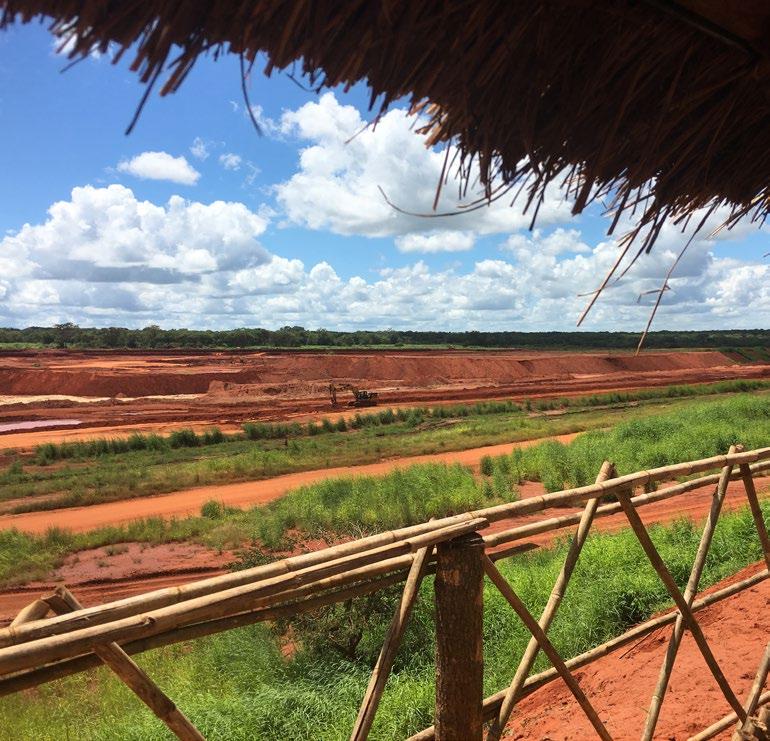
This, in turn, guides the exploration team in expanding these areas to maintain these recoveries.
Production is still focused around the Mugloto area within key sections that have been identified and have become expansion focal points.
Newer areas within the Maninge nice complex, Natete and Crongolasimba areas have been identified as promising. The MRM team is in the process of expanding these areas, which have been mechanically isolated due to a very intense rainy season. The team is very optimistic about the future of these areas.
MRM-funded vocational training centre to provide training for up to 700 young people a year.

MRM will increase the annual capacity at its Vocational Training Centre (VTC) in the Namanhumbir administrative post in the Montepuez district of Cabo Delgado province. MRM expects the number of annual trainees to increase from around 300 to 700 young people, with the introduction of a new workshop gallery for courses in civil construction, painting and plumbing, which currently take place in a temporary facility.



JANUARY, CHINA

We launched our second consumer research report focusing on the China market: Ruby - Breaking Out of Collectors’ Cabinets, Becoming Part Of China’s Middle Class Lifestyle. This research focuses solely on ruby, deep-diving into dialogue with China’s middle-class consumers to examine the impact of the postpandemic era on their purchase habits, attitudes and motivations. The research told us that these consumers are looking to buy rubies in everyday-wear jewellery pieces, and to learn more about ‘how to buy rubies’. Consequently, we will focus our marketing efforts on this area, seeking suitable jewellery brands to partner with and inspire consumers to purchase ruby jewellery.


Gemfields kicked off 2024 with a high-impact video-led campaign featuring actress Sophie Cookson. Following on from the 2017 campaign, this promotion was heavily centred around Fabergé and ran in both the US and UK across on-demand video channels, social media and out-of-home advertising.


Gemfields announced a collaboration with MonoC, the world’s first metahuman artist, in China. The aim was to encourage Chinese consumers see meaning in rubies, associate rubies with love, and highlight the auspicious colour red. This collaboration employed a surreal artistic perspective to explore rubies, enjoying the freedom of the virtual world over a two-part film. The result was high engagement over social media channels, with consumers driven to an e-commerce site selling Gemfields rubies in Fabergé rings.
Sophie Cookson, Gemfields Ad Campaign

Kelly Rowland dazzles in Shruti Sushma x Gemfields jewellery while attending the 2024 amfAR Gala during the Cannes Film Festival



For Valentine’s Day, a vibrant campaign promoting Gemfields jewellery brand partners was promoted across social channels, leading to international press coverage of a variety of jewellery pieces featuring emeralds and rubies. Gemfields commissioned a playful opinion poll to investigate consumer sentiment towards coloured gemstones as romantic gifting options. The survey revealed that nearly half of those considering a jewellery purchase for a loved one this February intended to buy a piece featuring one of the so-called “big three” coloured gems.

Gemfields launched two new jewellery brand partners – IVY New York and Shruti Sushma – in order to increase the visibility of coloured gemstones in key markets and highlight the versatility of coloured gemstones. Jewellery brand partnerships allow consumers to buy into the beauty of coloured gems, and we seek a variety of brand partners in order to widen that appeal. In May, for ‘emerald month’, we are launching two new collaborations: our first partnership with a Chinese fine jewellery brand, Midnight Opera House, and a new capsule collection with a British brand, Fenton.


Building on from our efforts in 2022 and 2023, emerald month is once again a key moment for Gemfields, and throughout the month we are supporting the industry with an emerald advertising campaign, created with beautiful inclusion imagery from Lotus Gemology. The visuals highlight the natural beauty of emeralds, and aim to help consumers to see what makes these green gems so special. The campaign runs across print media, out-of-home, and social channels.
Goliath, our gentle giant, has been busy travelling the world to educate consumers on emerald formation and the beauty of emerald crystals!
With thanks to L’ÉCOLE Middle East (supported by Van Cleef & Arpels), Goliath occupied a prominent position in the “Garden of Emeralds” exhibition in Dubai, which ran until March 2024. The colossal gem cluster was showcased in a dedicated hexagonal case – the shape a nod to the emerald crystal structure –offering a 360-degree view of its majestic formation.
Part of the “Discover the Gemstones” series, the “Garden of Emeralds” exhibition presents the research into emeralds carried out by L’ÉCOLE, School of Jewelry Arts. Its aim is to introduce as many people as possible to the scientific, cultural, artistic and technical aspects of this gem.
The “Garden of Emeralds” exhibition, enriched with other rarely-exhibited specimens, is now travelling to L’ÉCOLE in Shanghai, where its doors will be open from 24th May - 6th October 2024.
For more information, please see: Exhibition “Garden of Emeralds” | L’ÉCOLE School of Jewelry Arts (lecolevancleefarpels.com)
look at the scale!


“Garden of Emeralds” Exhibition 24th May - 6th October




There has been much talk of late regarding the rise in popularity of synthetic diamonds, as well as their downward price slope. For those of us in the colored gemstone trade this is not surprising; synthetic ruby has been factory produced for over a century, and since synthetics can be made in any quantity, prices are a mere fraction of natural gems.
As lab gemologists, we see the timeless beauty of natural stones each time we examine a gem in the microscope. Gems in nature generally possess a unique set of features termed “inclusions,” a microcosm that spans millions of years of the Earth’s history. When you examine a natural stone under magnification, you take a journey back in time, literally to the birth of the gem. This is one of the characteristics that makes natural gems so coveted.
to their reports. Inclusions can also act as unique identifying features for each stone.
Over the last few years, we have collaborated with our friends at L’École, School of Jewellery Arts, the educational arm of the famous French haute jewellery house, Van Cleef & Arpels. L’École conducts outreach campaigns to teach the public about gems and jewelry. Via exhibitions and lectures we have been pleased to introduce audiences across the globe to the magical internal world of precious stones.
‘‘the timeless beauty of natural stones.’’
Thus, when Gemfields approached us to integrate our photomicrographs of Mozambican rubies and Zambian emeralds with their latest advertising campaigns, we jumped at the chance.
At Lotus Gemology, we have done extensive research on the subject of gem inclusions, for they provide valuable clues about the places where gems originate, along with data that helps us separate natural gems from those made by man, and even identify those that are artificially treated.
But inclusions are not just data points. In many cases they are as stunningly beautiful as the gems themselves. Their splendor has fostered increased interest in these tiny features among our clients. In fact, some now request photomicrographs be added
For those who wish to traverse this stunning world, we invite you to explore Hyperion, our searchable online inclusion database, featuring more than 1,600 photomicrographs from a variety of different gem types.
It is our hope that through a better understanding of gemstones, we can encourage a greater appreciation of these natural treasures.


Gemfields is aligning its operations with IRMA, a world-leading standard for responsible mining that is focused on human rights and environmental protection.
IRMA distinguishes itself from other mining standards (such as the RJC) by involving local communities at all stages, ensuring their perspectives help shape core aspects of a mine’s operation – from water management and biodiversity protection to security, health and safety.
IRMA’s global governance is also multi-stakeholder, including representatives from the community, investors and those with mining backgrounds, ensuring the standard is up-to-date, comprehensive and balanced.
Putting communities and the environment at the heart of our international standards work supports Gemfields’ wider commitment to maximise financial and nature-based value for host countries and to mitigate risks collaboratively.
By aligning with IRMA, we intend to service customers with confidence in our commitment to responsible mining, with third-party assurance at the point of audit providing evidence of this aspiration, which meets or exceeds the demands of both end-consumers and incoming regulation.


We have been working to align MRM with IRMA since the summer of 2023, working towards an internal audit in July 2024 and a planned external audit at the end of 2024.

We look forward to sharing results in early 2025, at which time work to align Kagem with IRMA will be underway.

Having completed several brand audits, Gemfields has established closer relationships and a stronger dialogue with large jewellery brands, welcoming independent audits and suggestions for continuous improvement, as well as continued conversations to pursue greater transparency and improvements within our industry.
There is always more to do, and we are committed to the long-term vision of delivering a positive impact.
A key Gemfields tenet is that Africa’s gemstone wealth must contribute meaningfully to the next generation. With this ethos, the Group of companies has undertaken numerous projects to date.
Over the years, Gemfields has also facilitated requests from visitors to the mines who wished to build schools, provide educational equipment, and even footballs! Gemfields provided both the expertise and the management skills needed to bring them to life, free of charge.
This is what Gemfields Foundation does. Funds received from third parties are put directly to use, and Gemfields provide the needed expertise and management skills to do so, free of charge.
THE FOUNDATION IS A UK-REGISTERED CHARITY THAT FACILITATES PROJECTS FOR:
• the prevention or relief of poverty
• the advancement of animal welfare and the conservation and protection of wildlife and natural habitats
Projects completed by the Foundation to date: Montepuez computer lab, meals provided to École la Bénédiction students, Antsahamarofoza primary school rebuild, new classrooms at EPP Antanibe, École la Bénédiction primary school rebuild.
More information can be found at gemfieldsfoundation.org

Montepuez Secondary School computer lab, Mozambique
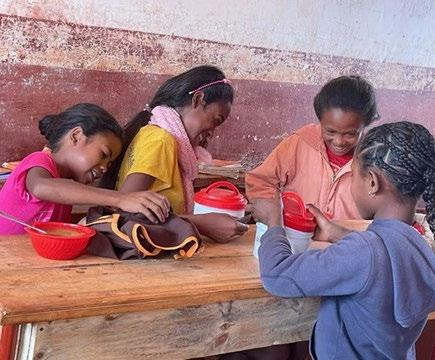
Children enjoying warm lunches at EPP Antanibe

Inauguration event for computer lab

Antsahamarofoza Primary School, Madagascar


Emeralds have long been the currency of empires. Ever since Cleopatra made this vibrant green gemstone the signature of her kingdom, emeralds have been seducing the great and the good. They were used as a colourful display of wealth and show of force under the Roman emperor Julius Caesar, and as a symbol of peace and restoration under Augustus; they were an obsession for Napoleon, and a forbidden item for anyone other than the emperor Justinian and his wife Theodora in Byzantine times.
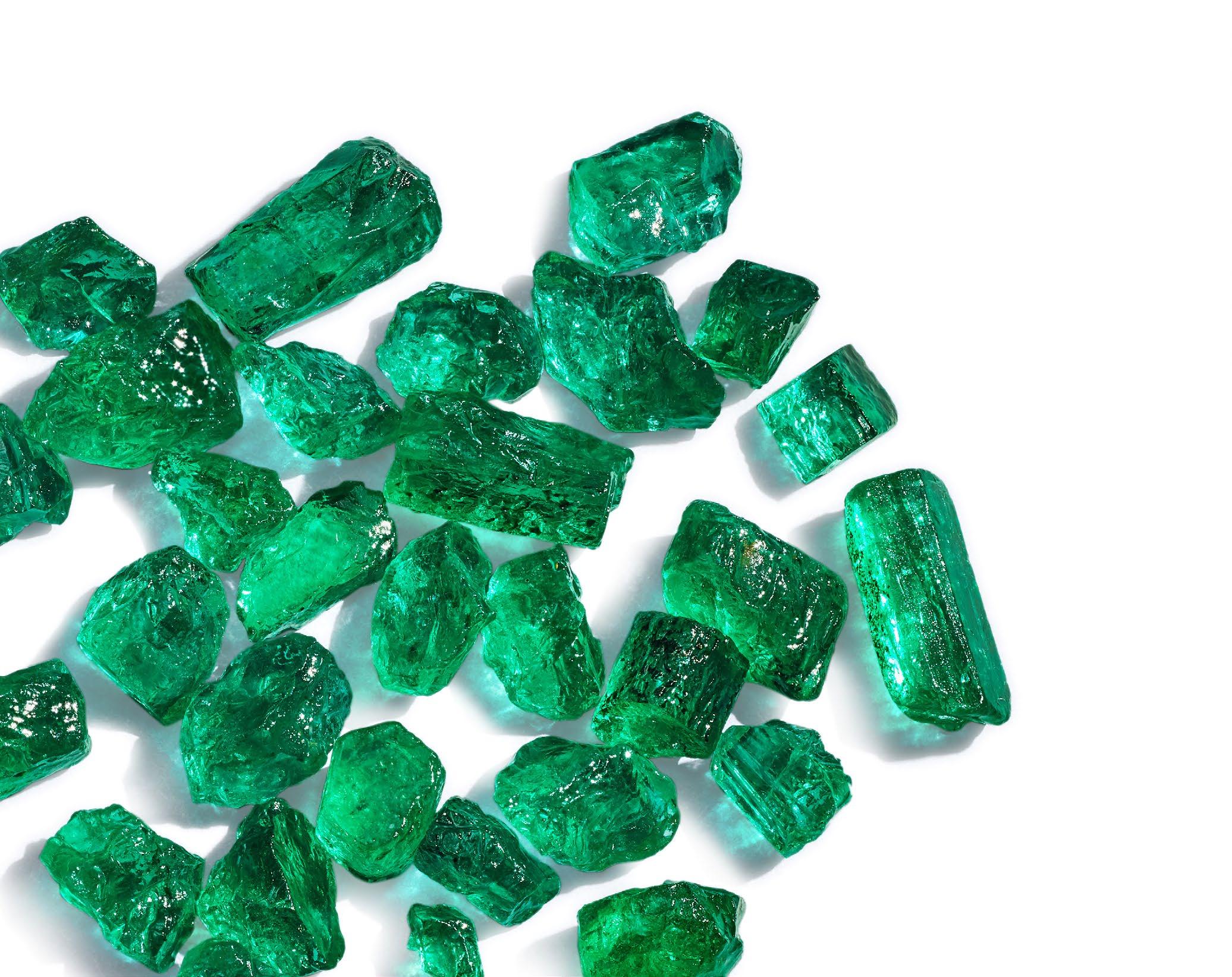

The human fascination with emeralds is a thread woven through our collective history. Early humans, captivated by the beauty of colour and the desire to possess enduring treasures, fell in love with this gemstone. In a world where everything else aged and withered, the unchanging beauty of emeralds was a source of awe, desire and admiration. The only logical explanation for their existence was that they were somehow divine, forever linked to the spiritual world.
It has always been widely held that green is a relaxing colour, and emeralds have been ascribed talismanic qualities; they are thought to symbolise good health, the green shoots of Spring, fertility and abundance. Although there are other green gemstones commonly used in jewellery – peridot, jade and tsavorite, for instance –scarcity is what sets emeralds apart.
Emeralds are formed from a rare combination of uncommon elements, namely chromium and beryllium, which are usually found at entirely different depths in the earth’s crust. Chromium is found in minute amounts in the ultramafic rock that makes up a significant portion of the oceanic crust, while beryllium is usually embedded in much newer igneous rocks that form peaks and highlands. These igneous rocks, known as pegmatites, are formed on land by cooled molten magma.
opened mines in Chivor, Muzo and other localities in the mid-1500s.
Emerald mining in East Africa is much newer and can be traced back to the 1970s, despite the fact that Zambian emeralds formed more than 500 million years ago.
When an emerald is unearthed from the ground, the first ray of sunlight travelling directly through the gemstone gives it its glowing colour for the very first time. Zambian emeralds’ colour results from chromium, vanadium and iron impurities in their simple hexagonal beryl structure. In Mother Nature’s cookbook, iron is pivotal in bonding the elements tighter, making the crystal less fragmented and more wearable in everyday jewellery.
‘‘a royal gemstone... the result of an impossible chemical love affair, formed under the most unlikely of circumstances.’’
In essence, beryllium and chromium are like the Romeo and Juliet of the elements, and the emeralds that form from their union are regarded as true scientific marvels.
As a gemmologist, I am fascinated by the science and romance of emerald: a royal gemstone with incredible beauty and history, the result of an impossible chemical love affair, formed under the most unlikely of circumstances.
Emeralds originating from different parts of the world present slightly different features. Historically, Colombia was the primary source of emeralds, dating back to when the Spanish conquistadores
Zambian emeralds have a distinctive colour, which can be described as a sharp, evenly-distributed green that glows with a tint of blue. Internally, microcosms of natural prodigies can be observed under the gemmological lens. Internal features are Mother Nature’s fingerprint and a telltale sign that the gemstone has travelled through time, environments and conditions that will remain in its memory forever.
The formation of each gem influences the decisions made by the lapidary, who unfolds magical sparkles from within each gem after it has been unearthed. Emerald cutting is still done using traditional methods and simple tools that have been perfected over time.
The first cut imposed on a rough gem ends one story and begins a new one. Most commonly, the cutter will opt for an emerald-cut: a classical, rectangular shape with bevelled corners that elegantly enhance light reflections, reduce stress and maximise weight retention in the rough-to-cut transformation. The cut emerald eventually chooses its setting and its new owner, as gemstones are believed to have the power to tap into the inherent human weakness for beautiful things.
A new book exploring real- life gemstone adventures across Africa over the last 60 years.
No Stone Unturned: The Hunt for African Gems takes readers on a thrilling rollercoaster ride with 24 adventure stories based on true events spanning the last 60 years. These tales, recounted by captivating personalities from the gem trade to author Richa Goyal Sikri, capture the fast-paced and dramatic nature of the business, as well as historical moments related to notable gem deposits in Africa. Each story brings to life the exhilarating highs and perilous lows of the trade, offering an insightful look into the vibrant journey of coloured gemstones from mine to market.
“The spirit of adventure deep-rooted in the coloured gemstone industry is rarely captured, and the wonderful characters that make this industry so colourful too often take their stories to the grave,” remarks Gemfields’ CEO Sean Gilbertson. “Gemfields commissioned this book in 2020 to capture some of these stories and to honour legendary individuals from the industry and tell their tales of courage, luck, energy, passion and expertise. Richa has diligently captured countless hours of stories and injected her energetic writing style to create a first-of-a-kind work that inspires and intrigues readers as they accompany marvellous personalities on journeys through the world of coloured gemstones.”
The author, Richa Goyal Sikri, explains: “This book aims to shine a light on African gem deposits. Hopefully, the stories will transport you to a vibrant world, where you’ll learn, laugh, fall in love and, like me, never want to leave.”
No Stone Unturned is Richa’s first book, published by Austin Macauley Publishers, and is available on austinmacauley.com, online retail platforms like Amazon and all major booksellers.
Order now
No Stone Unturned | Austin Macauley Publishers
US - Barnes and Noble
Amazon UK (Kindle)
Amazon US



